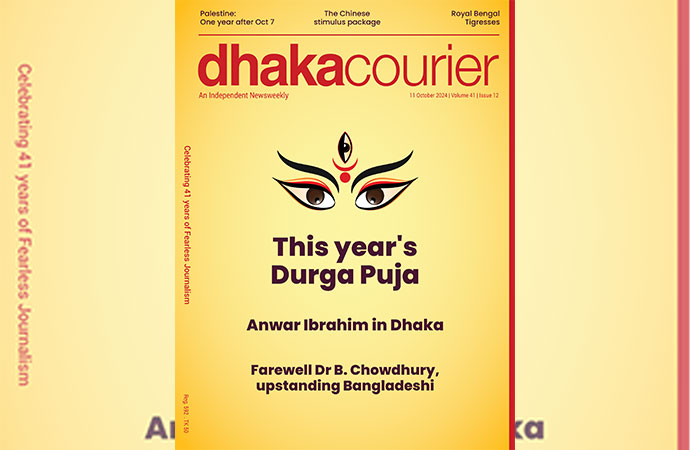Essays

"People can easily be recognized through their way of smiling. All human beings cry in the same pattern, with the same facial expression, and in almost same style- but everyone smiles differently. The unique style of smiling can easily differentiate every single human being from each other".
The quote of such caliber can easily be imagined as some sort of deep-routed observation and critical thought on human nature from someone who is a psychologist, writer or litterateur. However, what if this simple yet majestic observation came out of a person's stream of consciousness, who was a Ph.D. holder on polymer chemistry? Would anyone ever saw Einstein wrote a song, Shakespeare formulated any chemical equation, or Picasso answered myths about rocket science?
The answer can obviously be imagined by all- however, there was a magician in this country who actually balanced between Science and Arts. He was a writer, novelist, dramatist, screenwriter, filmmaker, songwriter- and a scholar, science-fiction writer and lecturer as well, all within one talented and compassionate soul. Compassionate is a perfect word to tribute him, because he empowered the youth and the middle class lives, along with their ups and downs in his legendary narratives and literary creations. Iconic bohemians such as Himu, Baker Bhai and classy dreamgirls such as Rupa, Muna or the maestro of mysteries, Misir Ali- they all impacted millions of admirers in both the Bengals for years. In this lucky country, there was one Humayun Ahmed- the most versatile and celebrated Bengali writer after Rabindranath Tagore and Kazi Nazrul Islam. A man of logic, and a lifelong bohemian by nature within his soul.
Born to a father who was a freedom fighter and martyr in Bangladesh's Liberation War, and a mother who then managed to take care and grew her six children successful with utmost patience and endurance, Humayun was destined to be great- though he earned and achieved every bit of his success on his own. Netrokona district's Kendua Upazila is a lucky place indeed among other places, as Humayun was born there to the police officer and liberation war martyr Foyezur Rahman Ahmed and Ayesha Foyez in 13th November, 1948. The reason behind labeling Kendua as a lucky place is not only Humayun, but also his two brothers among total of his five siblings- prominent science fiction writer, educationist and child litterateur Muhammad Zafar Iqbal, and one of the best cartoonists and satirists in the country, Ahsan Habib.
During Humayun's childhood, he lived in several districts such as Sylhet, Comilla, Chittagong, Bogra, Dinajpur and Panchagarh because of his father's official assignment and duty as police officer. Those shifting from one place to another, actually helped him to grow with learning about people from different areas and localities. He successfully completed his SSC from Bogra Zilla School, HSC from Dhaka College and both of his bachelor's and master's in chemistry from the University of Dhaka. As the family lost Foyezur Rahman Ahmed when all of his siblings were still very young, the family had to suffer economical crisis. So Humayun wasted no time and immediately joined Dhaka University as a lecturer in his own department, and later he flew to the United States to earn his PhD in polymer chemistry from North Dakota State University. Meritorious, indeed.
So what about the legendary litterateur, who had become the most celebrated after Tagore and Nazrul? When was his magical journey towards literature actually started? Well, the journey began during the war when he was a student at Dhaka University. His mentor and Bangladesh's best philosopher Ahmed Sofa, who himself was a maestro of storytelling- took the initiative to publish Humayun's first novel 'Nondito Noroke' (In Blissful Hell) right after independence in 1972- and that was a massive hit because with his very first novel, he started with thematic portrayal of average middle-class aspirations of urban families, and quintessential moments of their lives- which can be frequently seen in maximum of his books. His successful journey in television industry began with Prothom Prohor (1983), directed by Bangladesh Television (BTV)'s most popular producer Nawazish Ali Khan; however, it was his drama serial Ei Shob Din Ratri (1985) which spread his name to every home. As BTV was the only medium of entertainment during that time, his drama serials such as Bohubrihi (1988), Ayomoy (1988), Kothao Keu Nei (1990), Nokkhotrer Raat (1996), and Aaj Robibar (1999) created buzz in everywhere and made him the most popular dramatist of his time. Despite authoring almost two hundred books which made him bestseller writer for years even after his death in the annual Ekushey Book Fair, and 8 incredible films which he directed including Aguner Poroshmoni, Srabon Megher Din, Dui Duyari, Shyamol Chhaya, Ghetuputro Komola etc.- his drama serials brought him his first breakthrough among the mass audience even to those who were not his readers.
So what about his content, how good was his visual narrative? Here comes the most notable event of all in the history of Bengali television. Baker bhai, the evergreen gangster protagonist with a good heart and the central character of the drama series 'Kothao Keu Nei'- was scheduled to face execution as punishment. It was a fiction, just a fiction- yet history was made when people literally started protesting on the road in demand of Baker Bhai's independence! Can this really be imagined, even at this time?
He was certainly the best 'character creator' along with being the best content creator of his time, but his creations of bohemian characters made him very close to the hearts of million youths in this country. From Himu, the iconic vagabond with yellow Panjabi along with no slippers and moneybag- to the mysterious Misir Ali, a professor who believes nothing is above logic and is often compared to the great Sherlock Holmes- they all are classic bohemians in Bangladeshi literature. Millions of men dreamed and dared to be like Himu within their soul, admiring his true to the nature, minimalistic lifestyle. Whenever anything goes beyond logic, the readers of Humayun automatically recall Misir Ali to solve the issues with logic. Humayun's maximum narratives of liberation war in 1971, were portrayed in his books and films through the narrative of a bohemian. Humayun himself was a bohemian and a nihilist- which is why he made an entire estate called Nuhash Palli (named after his son Nuhash Humayun) at Gazipur just to seek the bonding between his soul and nature, and the place where he is now laying in his eternal peace.
His body and mind stopped working officially at this very day back in 19th July of 2012, at New York's Bellevue Hospital- however, the legacy of bohemian love that he always preached through his creations, continued. His admirers still awaits for and get amazed by full moonlit nights and first rain along with kadamba flower in the rainy season; lovers like Himu and Rupa still dresses up in yellow Panjabi and Blue saree avoiding all the exaggeration of capitalism; his readers still get mesmerized by diving into his polarizing stories, songs, drama serials and films- even though he is not around anymore. Humayun Ahmed, the beloved litterateur who single handedly shifted the capital of Bengali literature from Kolkata to Dhaka- was indeed a man outside of the box. He was the most deservingly celebrated literary person of this country who felt for everyone and made bohemianism look cool- and the compassionate genius who gave a much needed breathing space to the middle class, through his majestic creations.

























Leave a Comment
Recent Posts
In stormy seas, they steadied ...
As the interim government of Nobel Laureate Prof. Muhammad Yunus compl ...
Why the Munia Murder case must ...
It was late in the afternoon of April 26 in 2021, just after 3pm, that ...
Bangladesh and India are preparing for a high-level ..
Dr Yunus sees ill-efforts at home, abroad to make go ..
Desired elections on completion of necessary reforms ..
Pope Francis has called for an investigation to dete ..